2011 CHEVROLET COLORADO suspension
[x] Cancel search: suspensionPage 189 of 392
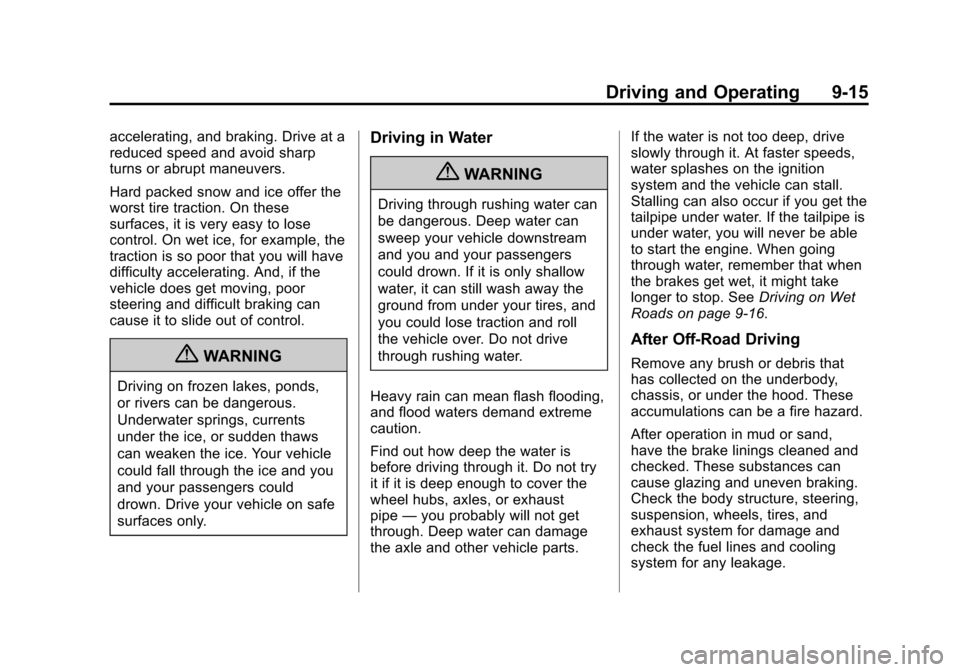
Black plate (15,1)Chevrolet Colorado Owner Manual - 2011
Driving and Operating 9-15
accelerating, and braking. Drive at a
reduced speed and avoid sharp
turns or abrupt maneuvers.
Hard packed snow and ice offer the
worst tire traction. On these
surfaces, it is very easy to lose
control. On wet ice, for example, the
traction is so poor that you will have
difficulty accelerating. And, if the
vehicle does get moving, poor
steering and difficult braking can
cause it to slide out of control.
{WARNING
Driving on frozen lakes, ponds,
or rivers can be dangerous.
Underwater springs, currents
under the ice, or sudden thaws
can weaken the ice. Your vehicle
could fall through the ice and you
and your passengers could
drown. Drive your vehicle on safe
surfaces only.
Driving in Water
{WARNING
Driving through rushing water can
be dangerous. Deep water can
sweep your vehicle downstream
and you and your passengers
could drown. If it is only shallow
water, it can still wash away the
ground from under your tires, and
you could lose traction and roll
the vehicle over. Do not drive
through rushing water.
Heavy rain can mean flash flooding,
and flood waters demand extreme
caution.
Find out how deep the water is
before driving through it. Do not try
it if it is deep enough to cover the
wheel hubs, axles, or exhaust
pipe —you probably will not get
through. Deep water can damage
the axle and other vehicle parts. If the water is not too deep, drive
slowly through it. At faster speeds,
water splashes on the ignition
system and the vehicle can stall.
Stalling can also occur if you get the
tailpipe under water. If the tailpipe is
under water, you will never be able
to start the engine. When going
through water, remember that when
the brakes get wet, it might take
longer to stop. See
Driving on Wet
Roads on page 9‑16.
After Off-Road Driving
Remove any brush or debris that
has collected on the underbody,
chassis, or under the hood. These
accumulations can be a fire hazard.
After operation in mud or sand,
have the brake linings cleaned and
checked. These substances can
cause glazing and uneven braking.
Check the body structure, steering,
suspension, wheels, tires, and
exhaust system for damage and
check the fuel lines and cooling
system for any leakage.
Page 198 of 392
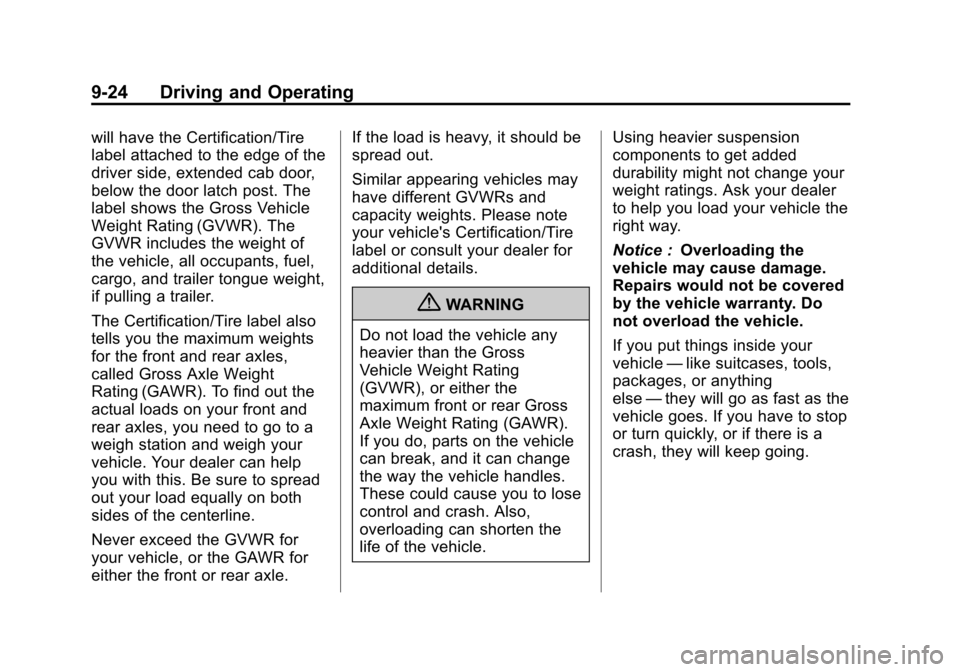
Black plate (24,1)Chevrolet Colorado Owner Manual - 2011
9-24 Driving and Operating
will have the Certification/Tire
label attached to the edge of the
driver side, extended cab door,
below the door latch post. The
label shows the Gross Vehicle
Weight Rating (GVWR). The
GVWR includes the weight of
the vehicle, all occupants, fuel,
cargo, and trailer tongue weight,
if pulling a trailer.
The Certification/Tire label also
tells you the maximum weights
for the front and rear axles,
called Gross Axle Weight
Rating (GAWR). To find out the
actual loads on your front and
rear axles, you need to go to a
weigh station and weigh your
vehicle. Your dealer can help
you with this. Be sure to spread
out your load equally on both
sides of the centerline.
Never exceed the GVWR for
your vehicle, or the GAWR for
either the front or rear axle.If the load is heavy, it should be
spread out.
Similar appearing vehicles may
have different GVWRs and
capacity weights. Please note
your vehicle's Certification/Tire
label or consult your dealer for
additional details.
{WARNING
Do not load the vehicle any
heavier than the Gross
Vehicle Weight Rating
(GVWR), or either the
maximum front or rear Gross
Axle Weight Rating (GAWR).
If you do, parts on the vehicle
can break, and it can change
the way the vehicle handles.
These could cause you to lose
control and crash. Also,
overloading can shorten the
life of the vehicle. Using heavier suspension
components to get added
durability might not change your
weight ratings. Ask your dealer
to help you load your vehicle the
right way.
Notice :
Overloading the
vehicle may cause damage.
Repairs would not be covered
by the vehicle warranty. Do
not overload the vehicle.
If you put things inside your
vehicle —like suitcases, tools,
packages, or anything
else —they will go as fast as the
vehicle goes. If you have to stop
or turn quickly, or if there is a
crash, they will keep going.
Page 236 of 392
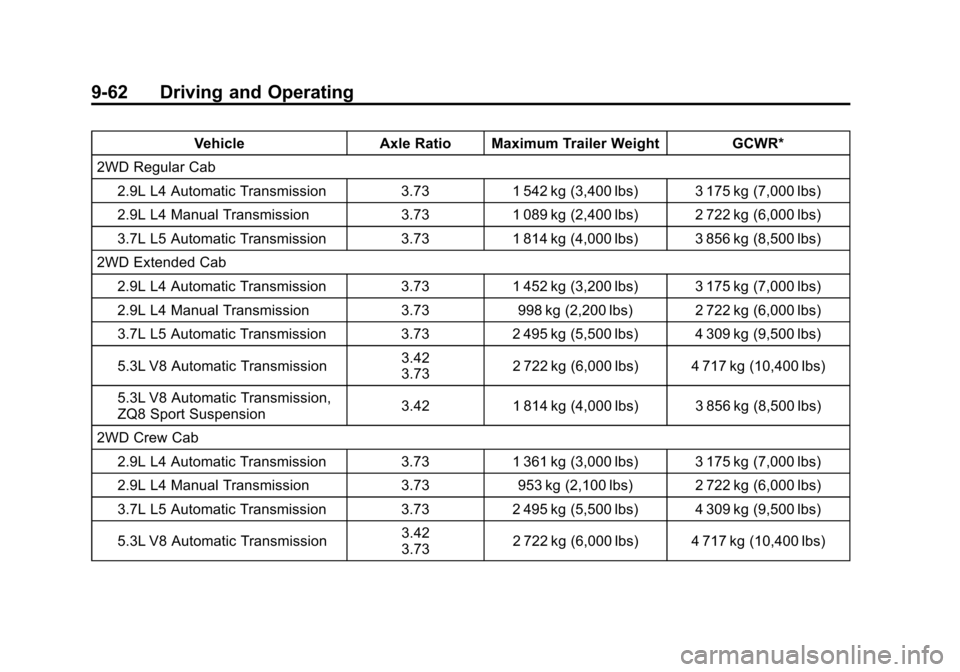
Black plate (62,1)Chevrolet Colorado Owner Manual - 2011
9-62 Driving and Operating
VehicleAxle Ratio Maximum Trailer Weight GCWR*
2WD Regular Cab 2.9L L4 Automatic Transmission 3.731 542 kg (3,400 lbs) 3 175 kg (7,000 lbs)
2.9L L4 Manual Transmission 3.731 089 kg (2,400 lbs) 2 722 kg (6,000 lbs)
3.7L L5 Automatic Transmission 3.731 814 kg (4,000 lbs) 3 856 kg (8,500 lbs)
2WD Extended Cab
2.9L L4 Automatic Transmission 3.731 452 kg (3,200 lbs) 3 175 kg (7,000 lbs)
2.9L L4 Manual Transmission 3.73998 kg (2,200 lbs) 2 722 kg (6,000 lbs)
3.7L L5 Automatic Transmission 3.732 495 kg (5,500 lbs) 4 309 kg (9,500 lbs)
5.3L V8 Automatic Transmission 3.42
3.732 722 kg (6,000 lbs) 4 717 kg (10,400 lbs)
5.3L V8 Automatic Transmission,
ZQ8 Sport Suspension 3.42
1 814 kg (4,000 lbs) 3 856 kg (8,500 lbs)
2WD Crew Cab 2.9L L4 Automatic Transmission 3.731 361 kg (3,000 lbs) 3 175 kg (7,000 lbs)
2.9L L4 Manual Transmission 3.73953 kg (2,100 lbs) 2 722 kg (6,000 lbs)
3.7L L5 Automatic Transmission 3.732 495 kg (5,500 lbs) 4 309 kg (9,500 lbs)
5.3L V8 Automatic Transmission 3.42
3.732 722 kg (6,000 lbs) 4 717 kg (10,400 lbs)
Page 237 of 392

Black plate (63,1)Chevrolet Colorado Owner Manual - 2011
Driving and Operating 9-63
VehicleAxle Ratio Maximum Trailer Weight GCWR*
5.3L V8 Automatic Transmission,
ZQ8 Sport Suspension 3.42
1 724 kg (3,800 lbs) 3 856 kg (8,500 lbs)
4WD Regular Cab 2.9L L4 Automatic Transmission 3.731 406 kg (3,100 lbs) 3 175 kg (7,000 lbs)
2.9L L4 Manual Transmission 3.73953 kg (2,100 lbs) 2 722 kg (6,000 lbs)
3.7L L5 Automatic Transmission 3.731 814 kg (4,000 lbs) 4 082 kg (9,000 lbs)
4WD Extended Cab 2.9L L4 Automatic Transmission 3.731 315 kg (2,900 lbs) 3 175 kg (7,000 lbs)
2.9L L4 Manual Transmission 3.73861 kg (1,900 lbs) 2 722 kg (6,000 lbs)
3.7L L5 Automatic Transmission 3.732 495 kg (5,500 lbs) 4 445 kg (9,800 lbs)
5.3L V8 Automatic Transmission 3.42
4.102 722 kg (6,000 lbs) 4 717 kg (10,400 lbs)
4WD Crew Cab 3.7L L5 Automatic Transmission 3.732 495 kg (5,500 lbs) 4 445 kg (9,800 lbs)
5.3L V8 Automatic Transmission 3.42
4.10
2 722 kg (6,000 lbs) 4 717 kg (10,400 lbs)
*The Gross Combination Weight Rating (GCWR) is the total allowable weight of the completely loaded vehicle and
trailer including any passengers, cargo, equipment and conversions. The GCWR for the vehicle should not be
exceeded.
Page 308 of 392
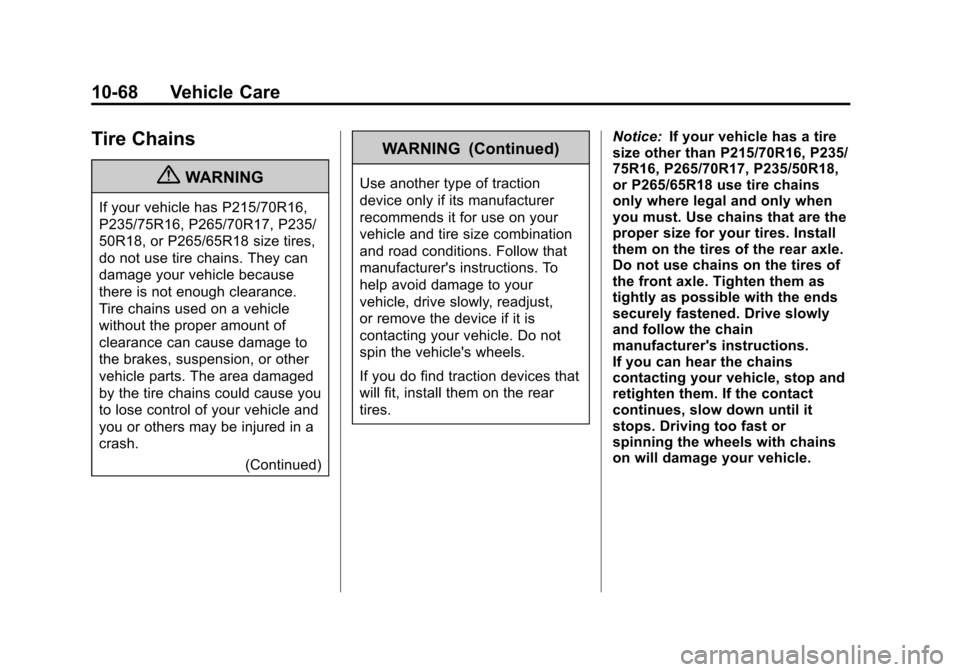
Black plate (68,1)Chevrolet Colorado Owner Manual - 2011
10-68 Vehicle Care
Tire Chains
{WARNING
If your vehicle has P215/70R16,
P235/75R16, P265/70R17, P235/
50R18, or P265/65R18 size tires,
do not use tire chains. They can
damage your vehicle because
there is not enough clearance.
Tire chains used on a vehicle
without the proper amount of
clearance can cause damage to
the brakes, suspension, or other
vehicle parts. The area damaged
by the tire chains could cause you
to lose control of your vehicle and
you or others may be injured in a
crash.(Continued)
WARNING (Continued)
Use another type of traction
device only if its manufacturer
recommends it for use on your
vehicle and tire size combination
and road conditions. Follow that
manufacturer's instructions. To
help avoid damage to your
vehicle, drive slowly, readjust,
or remove the device if it is
contacting your vehicle. Do not
spin the vehicle's wheels.
If you do find traction devices that
will fit, install them on the rear
tires. Notice:
If your vehicle has a tire
size other than P215/70R16, P235/
75R16, P265/70R17, P235/50R18,
or P265/65R18 use tire chains
only where legal and only when
you must. Use chains that are the
proper size for your tires. Install
them on the tires of the rear axle.
Do not use chains on the tires of
the front axle. Tighten them as
tightly as possible with the ends
securely fastened. Drive slowly
and follow the chain
manufacturer's instructions.
If you can hear the chains
contacting your vehicle, stop and
retighten them. If the contact
continues, slow down until it
stops. Driving too fast or
spinning the wheels with chains
on will damage your vehicle.
Page 347 of 392
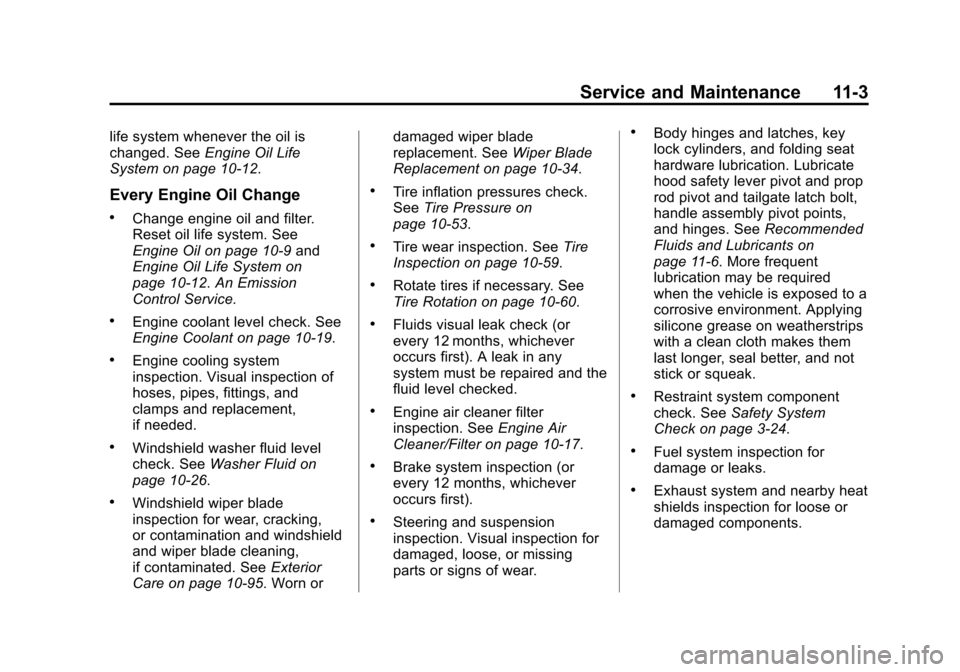
Black plate (3,1)Chevrolet Colorado Owner Manual - 2011
Service and Maintenance 11-3
life system whenever the oil is
changed. SeeEngine Oil Life
System on page 10‑12.
Every Engine Oil Change
.Change engine oil and filter.
Reset oil life system. See
Engine Oil on page 10‑9 and
Engine Oil Life System on
page 10‑12. An Emission
Control Service.
.Engine coolant level check. See
Engine Coolant on page 10‑19.
.Engine cooling system
inspection. Visual inspection of
hoses, pipes, fittings, and
clamps and replacement,
if needed.
.Windshield washer fluid level
check. See Washer Fluid on
page 10‑26.
.Windshield wiper blade
inspection for wear, cracking,
or contamination and windshield
and wiper blade cleaning,
if contaminated. See Exterior
Care on page 10‑95. Worn or damaged wiper blade
replacement. See
Wiper Blade
Replacement on page 10‑34.
.Tire inflation pressures check.
See Tire Pressure on
page 10‑53.
.Tire wear inspection. See Tire
Inspection on page 10‑59.
.Rotate tires if necessary. See
Tire Rotation on page 10‑60.
.Fluids visual leak check (or
every 12 months, whichever
occurs first). A leak in any
system must be repaired and the
fluid level checked.
.Engine air cleaner filter
inspection. See Engine Air
Cleaner/Filter on page 10‑17.
.Brake system inspection (or
every 12 months, whichever
occurs first).
.Steering and suspension
inspection. Visual inspection for
damaged, loose, or missing
parts or signs of wear.
.Body hinges and latches, key
lock cylinders, and folding seat
hardware lubrication. Lubricate
hood safety lever pivot and prop
rod pivot and tailgate latch bolt,
handle assembly pivot points,
and hinges. See Recommended
Fluids and Lubricants on
page 11‑6. More frequent
lubrication may be required
when the vehicle is exposed to a
corrosive environment. Applying
silicone grease on weatherstrips
with a clean cloth makes them
last longer, seal better, and not
stick or squeak.
.Restraint system component
check. See Safety System
Check on page 3‑24.
.Fuel system inspection for
damage or leaks.
.Exhaust system and nearby heat
shields inspection for loose or
damaged components.
Page 375 of 392

Black plate (13,1)Chevrolet Colorado Owner Manual - 2011
Customer Information 13-13
.Insurance company and policy
number.
.General description of the
damage to the other vehicle.
Choose a reputable repair facility
that uses quality replacement parts.
See “Collision Parts” earlier in this
section.
If the airbag has inflated, see What
Will You See After an Airbag
Inflates? on page 3‑31.
Managing the Vehicle Damage
Repair Process
In the event that the vehicle requires
damage repairs, GM recommends
that you take an active role in its
repair. If you have a pre-determined
repair facility of choice, take the
vehicle there, or have it towed there.
Specify to the facility that any
required replacement collision parts
be original equipment parts, either
new Genuine GM parts or recycled
original GM parts. Remember,
recycled parts will not be covered by
the GM vehicle warranty. Insurance pays the bill for the repair,
but you must live with the repair.
Depending on your policy limits,
your insurance company may
initially value the repair using
aftermarket parts. Discuss this with
the repair professional, and insist on
Genuine GM parts. Remember,
if the vehicle is leased, you may be
obligated to have the vehicle
repaired with Genuine GM parts,
even if your insurance coverage
does not pay the full cost.
If another party's insurance
company is paying for the repairs,
you are not obligated to accept a
repair valuation based on that
insurance company's collision policy
repair limits, as you have no
contractual limits with that company.
In such cases, you can have control
of the repair and parts choices as
long as the cost stays within
reasonable limits.
Service Publications
Ordering Information
Service Manuals
Service Manuals have the diagnosis
and repair information on the
engines, transmission, axle,
suspension, brakes, electrical,
steering, body, etc.
Service Bulletins
Service Bulletins give additional
technical service information
needed to knowledgeably service
General Motors cars and trucks.
Each bulletin contains instructions
to assist in the diagnosis and
service of the vehicle.